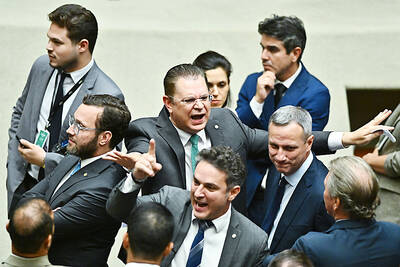US Defense Secretary Donald Rumsfeld on Wednesday criticized Venezuela's reported efforts to purchase 100,000 AK-47 assault rifles from Russia, suggesting that Venezuela's possession of so many weapons would threaten the hemisphere.
Harsh accusations and increasing animosity have marked the relationship between the US and Venezuela. Venezuela's president, Hugo Chavez, has warned that he will cut off shipments of his country's oil to the US if the Bush administration supports an attempt to force him from office.
Venezuela is the world's fifth largest oil exporter and provides about 13 percent of US crude oil imports.
Rumsfeld, during a four-day trip to Latin America, raised concerns about the reports of Venezuela's rifle purchases.
"I can't imagine what's going to happen to 100,000 AK-47s," Rumsfeld said at a news conference in Brasilia, the capital of Brazil, which shares a border with Venezuela. "I can't understand why Venezuela needs 100,000 AK-47s. I personally hope it doesn't happen. I can't imagine if it did happen it would be good for the hemisphere."
Rumsfeld appeared with Brazil's vice president and defense minister, Jose Alencar, who declined to offer similar criticism of Chavez. Alencar would only say that Brazil respects the right of self-determination of other countries.
Venezuela says its military has about 100,000 troops, plus 30,000 reservists. The US is concerned that the weapons are intended for domestic militias or foreign guerillas.
Venezuela had no immediate reaction to Rumsfeld's comments. Chavez has insisted that his government poses no threat to the region and top Venezuelan officials have defended the purchases as necessary replacements for existing weapons. Venezuelan officials also have said the weapons are solely for the military.
A senior US defense official, speaking about Venezuela only on condition of anonymity, said weapons are expected to arrive in a few months. Venezuela also is negotiating for the purchase of at least 40 Russian MiG-29 Fulcrum fighters, at least 30 Russian attack helicopters, and possibly some Spanish naval vessels, the official said, citing public statements from Venezuelan officials and US intelligence.
Some of the larger weapons systems, such as the helicopters, are useful in border patrol and other operations that the Pentagon regards as legitimate. But the small arms are harder to track and could more easily end up in criminal or guerrilla hands, even if Chavez does not intend for them to be transferred.
In addition, the US official said Chavez is looking to build a small arms ammunition factory that can make the 7.62mm bullets that are in common use among guerillas and criminals, as well as some militaries. That deal is in negotiation.
The chief guerrilla group in neighboring Colombia, the Revolutionary Armed Forces of Columbia, or FARC, has faced a shortage in such ammunition and is paying US$1 a round or higher, in some cases, the official said. The US state department considers FARC a terrorist organization; Brazil does not.
Many of these groups are armed with weapons and ammunition from Nicaragua, a former Soviet client. That source has dried up with a pro-US administration in power in Nicaragua.
Many Latin America nations has reduced the size of their militaries since the violence of the 1980s. Officials fear Chavez's actions could lead to a new arms race.

A plan by Switzerland’s right-wing People’s Party to cap the population at 10 million has the backing of almost half the country, according to a poll before an expected vote next year. The party, which has long campaigned against immigration, argues that too-fast population growth is overwhelming housing, transport and public services. The level of support comes despite the government urging voters to reject it, warning that strict curbs would damage the economy and prosperity, as Swiss companies depend on foreign workers. The poll by newspaper group Tamedia/20 Minuten and released yesterday showed that 48 percent of the population plan to vote

PARLIAMENT CHAOS: Police forcibly removed Brazilian Deputy Glauber Braga after he called the legislation part of a ‘coup offensive’ and occupied the speaker’s chair Brazil’s lower house of Congress early yesterday approved a bill that could slash former Brazilian president Jair Bolsonaro’s prison sentence for plotting a coup, after efforts by a lawmaker to disrupt the proceedings sparked chaos in parliament. Bolsonaro has been serving a 27-year term since last month after his conviction for a scheme to stop Brazilian President Luiz Inacio Lula da Silva from taking office after the 2022 election. Lawmakers had been discussing a bill that would significantly reduce sentences for several crimes, including attempting a coup d’etat — opening up the prospect that Bolsonaro, 70, could have his sentence cut to

A powerful magnitude 7.6 earthquake shook Japan’s northeast region late on Monday, prompting tsunami warnings and orders for residents to evacuate. A tsunami as high as three metres (10 feet) could hit Japan’s northeastern coast after an earthquake with an estimated magnitude of 7.6 occurred offshore at 11:15 p.m. (1415 GMT), the Japan Meteorological Agency (JMA) said. Tsunami warnings were issued for the prefectures of Hokkaido, Aomori and Iwate, and a tsunami of 40cm had been observed at Aomori’s Mutsu Ogawara and Hokkaido’s Urakawa ports before midnight, JMA said. The epicentre of the quake was 80 km (50 miles) off the coast of

RELAXED: After talks on Ukraine and trade, the French president met with students while his wife visited pandas, after the pair parted ways with their Chinese counterparts French President Emmanuel Macron concluded his fourth state visit to China yesterday in Chengdu, striking a more relaxed note after tough discussions on Ukraine and trade with Chinese President Xi Jinping (習近平) a day earlier. Far from the imposing Great Hall of the People in Beijing where the two leaders held talks, Xi and China’s first lady, Peng Liyuan (彭麗媛), showed Macron and his wife Brigitte around the centuries-old Dujiangyan Dam, a World Heritage Site set against the mountainous landscape of Sichuan Province. Macron was told through an interpreter about the ancient irrigation system, which dates back to the third century